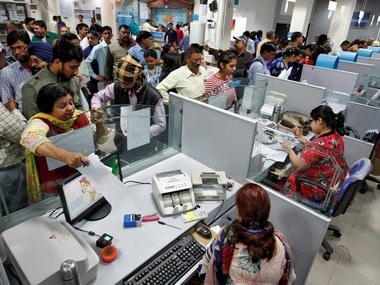The year 2019 was chaotic for the Indian financial sector and was nothing short of a roller-coaster ride. A tight liquidity scenario made the year difficult for Non-Banking Financial Company (NBFCs) too. For the commercial banking sector, it was a phase of
major consolidation in the public sector , while some banks gained bad press in the private sector for failure to adhere to golden standards of corporate governance and for alleged financial irregularities. [caption id=“attachment_7023271” align=“alignleft” width=“380”]
 Representational image. Reuters.[/caption] The year 2019 would be remembered also for
Punjab and Maharashtra Cooperative Bank (PMC) scam that came as a shocker for thousands of depositors, raising questions on regulation for cooperative banks and the painfully inadequate deposit insurance guarantee scheme that should be protecting depositors’ money in the event of a bank collapse. The recently released
financial stability report (FSR) by the Reserve Bank of India (RBI) has clearly spelled out the likelihood of bad loan problems continuing in the new year—but not in an alarming way. The gross NPA ratio of banks, which stood at 9.3 percent of the total loans in March 2019 could rise to close to 10 percent in September 2020, according to the FSR report. Much will depend on how the economic growth activity picks up. Courtesy: CMIE The
GDP growth slowed to 4.5 percent in the second quarter of the current fiscal, down from 5 percent in the first quarter. If the slowdown worsens, it could further hamper the ability of companies to pay lenders. In a slowing economy, there is typically low credit demand. In 2019, when the economy was slow, this was evident in the lending patterns of banks. Loan growth to industry slowed to a trickle and even contracted for large companies in the fiscal year so far. In the first seven months of the current financial year, the credit growth to large industries contracted by 3.4 percent as against a growth of 0.2 percent in the year-ago period. When it comes to medium-sized companies, loan growth shrunk by 0.8 percent as against a growth of 0.6 percent in the year-ago period. What lies ahead? The pain of sticky assets will continue unless the economy revives as the health of the banking sector is inseparably linked to the health of the larger economy. But the scenario may be less painful for banks in 2020 compared to 2019 since most of the big bad loans have already been identified and are under a resolution process. The bigger problem for banks will be to find the demand from corporations to grow their loan books. “There may be smaller corporate loans and some amount of NBFC loans that may turn bad. But, as a percentage of the overall book, these may not be significant to cause a concern,” Jaikishan Parmar, senior equity analyst at Angel Broking said. It makes sense for the RBI to initiate an official Asset Quality Review (AQR) for the non-banking finance companies to assess the full extent of crisis they are in and identify problematic assets, Parmar added. Some analysts, however, differ from this point of view. For instance, Siddharth Purohit, analyst at SMC global securities said the NBFC segment is too weak right now to withstand an asset quality review like the one implemented in the banking sector in 2015. “NBFCs are already under closer scrutiny by the RBI; just that the RBI may not have announced it formally. The regulator may be doing it on a case-to-case basis,” Purohit said.
In the AQR introduced by the RBI in 2015 under former governor Raghuram Rajan, the banking sector disclosed a substantial chunk of problematic loans that would otherwise have remained hidden in the system for long aided by constant evergreening. Banks’ gross NPAs jumped from Rs 2-3 trillion to close to Rs 10 trillion post-asset quality review.
The exercise resulted in banks setting aside a substantial chunk of money in the form of provisions to cover the declared bad loans. Undoubtedly, the process was painful for the sector but it helped to improve the health of the banking system after cleaning up the mess. Several bad loan accounts were pushed to the National Company Law Tribunal (NCLT) for speedier resolution. The progress of the resolution of loans under the Insolvency and Bankruptcy Code, 2016 is yet to show the desired results though. Analysts, however, believe that the Indian banking sector is largely out of the bad loan mess. The new year will not be very different from the year gone by for banks but the pain of bad loans is likely to be lesser with growth emerging as a major concern.


)

)
)
)
)
)
)
)
)



